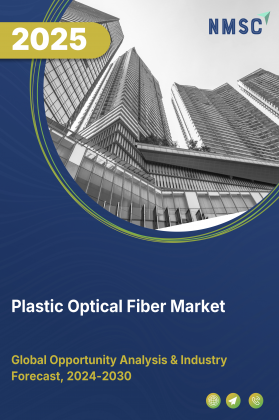
Plastic Optical Fiber Market by Material Composition (PMMA, Perfluorinated Polymers, Polycarbonate, Cyclic Olefin Copolymers), by Fiber Profile (Step-Index, Graded-Index, Microstructured), by Mode (Single-Mode, Multi-Mode), by End-Use Industry (IT & Telecommunications, Automotive, Consumer Electronics, Energy & Power, Healthcare, Aerospace & Defense, Industrial Automation & Control, Sensing & Instrumentation, Others) – Global Opportunity Analysis and Industry Forecast 2025-2030
Industry Overview
The global Plastic Optical Fiber Market size was valued at USD 8.68 billion in 2024, with an estimation of USD 10.52 billion in 2025 and is predicted to reach USD 27.52 billion by 2030 with a CAGR of 21.2% from 2025-2030.
The market is experiencing steady growth, driven by rising demand for affordable, high-speed, and EMI-resistant communication solutions across various sectors. Key growth drivers include the rapid expansion of smart cities such as India’s Smart Cities Mission backed by a USD 19.67 billion allocation, along with increasing adoption in automotive electronics, industrial automation, and smart homes.
POF’s ability to deliver gigabit-speed connectivity over short distances makes it ideal for modern, compact environments. However, the market faces limitations due to lower data transmission capacity compared to glass fiber, restricting its use in long-distance or high-bandwidth applications.
Despite this, emerging opportunities in medical and biometric applications, where POF’s safety, flexibility, and non-toxic properties are valued, are opening new avenues for growth. As demand for reliable, short-range connectivity continues to rise, POF is increasingly being adopted as a cost-effective solution in diverse use cases across both consumer and industrial markets.
Growth of Smart Cities and Intelligent Infrastructure Boosts the Market Growth
The rising investment in smart city initiatives is a key driver of the market, particularly in developing regions like India. As part of the Union Budget 2024–25, the Indian government allocated USD 19.67 billion to the Smart Cities Mission, according to India Brand Equity Foundation (IBEF). This reflects a strong national push toward intelligent urban infrastructure. Such projects involve the deployment of high-speed communication networks to support smart lighting, traffic management, surveillance, and environmental monitoring.
POF, with its flexibility, EMI resistance, and cost-effective short-range gigabit connectivity, is well-suited for these applications, enabling seamless data transmission across dense sensor networks embedded in roads, buildings, and public spaces. As smart infrastructure development accelerates, POF is increasingly being adopted as a practical solution for efficient urban connectivity.
Demand for Affordable Gigabit Connectivity Drives the Market Growth
The rising need for low-cost, gigabit-speed connectivity in smart homes and industrial automation is a key driver of the market. As connected devices and automation systems become more prevalent, there is growing demand for reliable data transmission at gigabit levels over short distances.
POF addresses this need by offering high-speed performance, strong resistance to electromagnetic interference, and simple, cost-effective installation. Its ability to deliver gigabit connectivity in compact, interference-prone environments makes it a preferred solution for bridging wired and wireless systems in modern home and industrial networks.
Rising Demand in Automotive and Consumer Electronics
The market is being driven by the growing need for high-speed, interference-free communication over short distances, particularly in the automotive and consumer electronics sectors. Modern vehicles increasingly rely on advanced driver-assistance systems (ADAS), infotainment, and sensor networks, all of which require reliable, lightweight, and EMI-resistant data transmission.
Similarly, in smart homes and personal electronics, the proliferation of high-bandwidth devices such as streaming systems, gaming consoles, and home automation hubs has created demand for fast, flexible, and easy-to-install cabling solutions. POF’s cost-effectiveness, immunity to electromagnetic interference, and suitability for short-range applications make it a preferred alternative to traditional copper or glass fiber in these fast-growing markets.
Limited Data Transmission Capacity Restricts Broader Adoption of the Market
A key restraint hindering the growth of the plastic optical fiber market growth is its limited data transmission capacity compared to traditional glass optical fiber. While POF is cost-effective and easy to install for short-distance applications, it generally supports lower bandwidth and shorter transmission distances, capped at under 1 Gb/s for typical step-index variants.
This makes it unsuitable for high-speed, long-distance communication systems, such as backbone internet infrastructure, data centers, or enterprise-level networks, where glass fiber remains the standard. The need for advanced graded-index POF to overcome these limitations adds to cost and complexity, reducing the economic appeal of POF in many potential high-performance applications and limiting its role to niche or consumer-level connectivity use cases.
Niche Medical and Biometric Applications Open New Growth Avenues for the Market
Niche medical and biometric applications present a significant opportunity for the growth of the market, as the demand for compact, safe, and interference-free communication systems rises in healthcare and security sectors. POF’s flexibility, non-toxicity, and immunity to electromagnetic interference make it ideal for use in wearable health monitors, minimally invasive diagnostic devices, and biometric sensors for tracking vital signs such as heart rate and oxygen saturation.
Additionally, its compatibility with sterile and high-hygiene environments positions it well for deployment in hospitals, clinics, and advanced biometric authentication systems. As healthcare technology and biometric security continue to evolve, POF is poised to gain traction in these specialized, high-growth applications.
Market Segmentations and Scope of the Study
The plastic optical fiber market report is segmented by material composition, fiber profile, mode, core diameter, distribution channel, application, end user, and region. Material composition includes core materials like PMMA, PF-POF, PC, COC, PET, and cladding materials such as FEP, PVC, and PE. By fiber profile, it includes step-index, graded-index, and microstructured POF. Applications span data transmission, lighting, imaging, and sensing. Distribution channels include OEMs, integrators, e-commerce, and retail. End users include IT, automotive, consumer electronics, healthcare, industrial automation, and more. The market spans North America, Europe, Asia-Pacific, and the Rest of the World.
Geographical Analysis
One key driver of the plastic optical fiber market share in North America is the rising demand for high-speed data transmission in automotive and home networking applications. As vehicles integrate more advanced systems like infotainment, ADAS, and in-car connectivity, automakers are increasingly turning to POF for its lightweight, cost-effective, and EMI-resistant properties. Similarly, the growth of smart homes across the U.S. and Canada, fuelled by rising broadband penetration and demand for connected devices has led to a greater need for flexible and easy-to-install cabling solutions like POF. These trends are collectively propelling the adoption of POF in the region.
In Europe, strict environmental and safety regulations are driving the shift toward safer, more sustainable materials in communication infrastructure, particularly in cabling systems. These regulations encourage the use of halogen-free, flame-retardant, and recyclable materials, making Plastic Optical Fiber (POF) an attractive alternative to traditional copper and glass cables.
Made from non-toxic polymers like PMMA, POF is easier to handle and safer to install, and it does not release harmful gases in the event of a fire. This makes it especially suitable for use in sensitive environments such as homes, schools, hospitals, and public buildings. As Europe continues to focus on green building practices and sustainable urban development, the adoption of POF is steadily increasing across various sectors.
One of the key drivers of the plastic optical fiber market in the Asia-Pacific region is the rapid growth and modernization of telecommunications infrastructure, particularly in countries like India. As the world’s second-largest telecommunications market, India had a total telephone subscriber base of 1,203.69 million in 2025, according to India Brand Equity Foundation (IBEF), reflecting the massive scale and connectivity demands of the region.
This surge in network expansion, fueled by increasing mobile and internet penetration, 5G deployment, and digital inclusion initiatives, has created a strong need for high-speed, cost-effective, and interference-resistant cabling solutions. POF, with its flexibility, ease of installation, and EMI immunity, is well-suited for short-distance, high-bandwidth telecom applications, making it a preferred choice in both urban and rural network deployments across Asia-Pacific.
The growth of industrial automation in emerging economies within the Rest of the World (RoW) region is driving the market by increasing the demand for reliable, affordable, and EMI-resistant communication solutions in modern manufacturing environments. As industries in countries such as Brazil, South Africa, and parts of the Middle East embrace automation to boost operational efficiency and global competitiveness, the need for robust internal data transmission systems has surged. POF’s flexibility, ease of installation, and immunity to electromagnetic interference make it well-suited for connecting sensors, machinery, and control systems in compact and noisy industrial settings, supporting the region’s transition toward smarter factories.
Strategic Innovations Adopted by Key Players
Key players in the plastic optical fiber industry are driving advancements through next-generation multi-core fiber innovation, strategic partnerships, material innovation, and portfolio expansion.
-
In May 2025, Sumitomo Electric Industries, Ltd. achieved a world record transmission of 1.02 petabits/sec over 1,808 km using 19‑core optical fiber with standard cladding. While this involves glass-fiber research, it underscores the company’s leadership in next-gen fiber innovation.
-
In March 2025, Prysmian Group announced acquisition of Channell Commercial Corporation (USA), expanding digital connectivity solutions. Not specifically POF, but relevant to their optical network capabilities.
-
In March 2025, Sumitomo Electric Industries, Ltd. announced a partnership with 3M to supply Expanded Beam Optical interconnect (EBO) assemblies optimized for both single-mode and multi-mode fiber applications in data centers.
-
In April 2024, the Toray Group participated in NPE 2024 (National Plastics Exposition) held in Orlando, Florida, where it showcased its cutting-edge engineering plastics, fiber, and composite materials. The exhibition highlighted Toray’s advanced polymer technologies, including those foundational to plastic optical fibers (POF) such as PMMA and PF-POF variants. This participation underscored Toray’s position as a key innovator in materials supporting short‑distance optical communication, sensing, lighting, and industrial fiber applications.
Key Benefits
-
The report provides quantitative analysis and estimations of the market from 2024 to 2030, which assists in identifying the prevailing industry opportunities.
-
The study comprises a deep-dive analysis of the current and future plastic optical fiber market trends to depict prevalent investment pockets in the sector.
-
Information related to key drivers, restraints, and opportunities and their impact on the market is provided in the report.
-
Competitive analysis of the players, along with their market share is provided in the report.
-
SWOT analysis and Porter's Five Forces model is elaborated in the study.
-
Value chain analysis in the market study provides a clear picture of the roles of stakeholders
Plastic Optical Fiber Market Key Segments
By Material Composition
-
Core Material
-
PMMA (Methyl Methacrylate)
-
Perfluorinated Polymers (PF-POF)
-
Polycarbonate (PC)
-
Cyclic Olefin Copolymers (COC)
-
Polyethylene Terephthalate (PET)
-
-
Cladding Material
-
Fluorinated Polymers (FEP, PFA)
-
Polyvinyl Chloride (PVC)
-
Polyethylene (PE)
-
By Fiber Profile
-
Step-Index POF (SI-POF)
-
Graded-Index POF (GI-POF)
-
Microstructured POF (mPOF)
By Mode
-
Single-Mode POF
-
Multi-Mode POF
By Core Diameter
-
Micro-core (<250 µm)
-
Standard core (250–500 µm)
-
Large-core (0.5–2.0 mm)
By Application
-
Data Transmission
-
Lighting
-
Imaging
-
Sensing
By End User
-
IT & Telecommunications
-
Automotive
-
Consumer Electronics & Smart Home
-
Energy & Power
-
Healthcare & Medical Devices
-
Aerospace & Defense
-
Industrial Automation & Control
-
Sensing & Instrumentation
-
Illumination & Light-Guiding
-
Food & Beverage
-
Others
By Distribution Channel
-
OEM & Direct Sales
-
Industrial Distributors & System Integrators
-
E-commerce & Online Retail
-
Traditional Electronics Retail
By Region
-
North America
-
The U.S.
-
Canada
-
Mexico
-
-
Europe
-
The UK
-
Germany
-
France
-
Italy
-
Spain
-
Denmark
-
Netherlands
-
Finland
-
Sweden
-
Norway
-
Russia
-
Rest of Europe
-
-
Asia-Pacific
-
China
-
Japan
-
India
-
South Korea
-
Australia
-
Indonesia
-
Singapore
-
Taiwan
-
Thailand
-
Rest of Asia-Pacific
-
-
RoW
-
Latin America
-
Middle East
-
Africa
-
Key Players
-
Toray Industries
-
Mitsubishi Chemical group Corporation
-
Sumitomo electric Industries Ltd
-
Industrial Fiber Optics
-
Edmund optics India private
-
Prysmian Group S.p.A
-
Laser Components GmbH
-
Thor labs
-
wenglor
-
AMS Technologies AG
-
Deufo Electric Co., Ltd.
-
IMO precision Controls LtD
-
FiberFin.
Report Scope and Segmentation
|
Parameters |
Details |
|
Market Size in 2025 |
USD 10.52 Billion |
|
Revenue Forecast in 2030 |
USD 27.52 Billion |
|
Growth Rate |
CAGR of 21.2% from 2025 to 2030 |
|
Analysis Period |
2025–2030 |
|
Base Year Considered |
2024 |
|
Forecast Period |
2025–2030 |
|
Market Size Estimation |
Billion (USD) |
|
Growth Factors |
|
|
Countries Covered |
28 |
|
Companies Profiled |
15 |
|
Market Share |
Available for 10 companies |
|
Customization Scope |
Free customization (equivalent up to 80 working hours of analysts) after purchase. Addition or alteration to country, regional, and segment scope. |
|
Pricing and Purchase Options |
Avail customized purchase options to meet your exact research needs. |

















 Speak to Our Analyst
Speak to Our Analyst

























